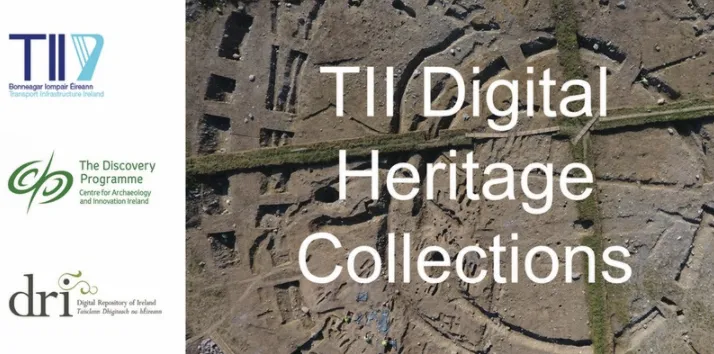On Monday 19th June 2017 at 5.30pm, the Transport Infrastructure of Ireland (TII) in collaboration with the Digital Repository of Ireland (DRI) and the Discovery Programme, launches the TII Digital Heritage Collections in the Royal Irish Academy, Dublin.
On Monday 19th June 2017 at 5.30pm, the Transport Infrastructure of Ireland (TII) in collaboration with the Digital Repository of Ireland (DRI) and the Discovery Programme, launches the TII Digital Heritage Collections in the Royal Irish Academy, Dublin. The collections will be formally launched by Minister of State for eGovernment, Eoghan Murphy, TD.
TII Digital Heritage Collections include more than 1,500 archaeological excavation reports, representing approximately 80% of all archaeological excavation reports commissioned by the National Roads Authority (NRA) and the Railway Procurement Agency (RPA) during Ireland’s infrastructure building programme between 2001 and 2016. In addition, the Collections include 90 papers from the NRA’s seminar proceedings, published between 2003 and 2009, as well as TII’s downloadable audiobooks and short videos.
The collections provide a fascinating opportunity to explore Ireland’s rich archaeological heritage from every time period and every region, including:
Mesolithic fish traps from Clowanstown, which are on display in the National Museum Ireland
The Bronze Age village of Ballybrowney in County Cork
A Tudor burial discovered outside Trinity College during excavations for Luas Cross City
The Clowanstown fish traps are also featured in the current collection of An Post stamps.
These collections are now securely preserved for the long term, and are accessible through the Digital Repository of Ireland. They will also be accessible from a variety of important national and international platforms, including Ireland’s Open Data Portal, HeritageMaps.ie (an initiative of the Heritage Council), the ARIADNE portal (a European-wide Research Infrastructure for archaeology), as well as the Discovery Programme and TII websites. These multiple points of data discovery provide access to these rich collections to the general public and professionals alike.
Commenting on the launch, Rónán Swan, Head of Archaeology and Heritage at TII, said: ‘These collections represent the endeavour of numerous archaeologists and site directors, who painstakingly excavated these sites’.
Referring to the collections as a ‘wealth of archaeological information’, Swan continued: ‘For TII, making this information accessible and available for the long term through the DRI is entirely consistent with our stated objectives.’
Director of the Digital Repository of Ireland, Dr. Natalie Harrower, said: ‘The publication of these rich collections is the result of a true collaboration between parties with complementary areas of expertise. The collections provide an amazing corpus for researchers and general interest browsing, but also, importantly, TII and the Discovery Programme were committed to ensuring long-term preservation, enhanced discovery, and widespread access from the very beginning. These are goals we hold in common, and it is a joy to partner with organisations who are committed to best practices in data preservation.’
Anthony Corns, Technology Manager at the Discovery Programme pointed to the broader dimension of the project in an era of rapid change in digital data management: ‘The “digital dark ages” has become the buzzword for an ever-changing, fragile and expanding digital universe. In this context it is important for cultural heritage stakeholders to recognise the urgent need to address the potential loss of valuable digital data on a large scale,’ he said.
‘The Discovery Programme was keen to support this significant project to preserve and catalogue digital archaeological data from Transport Infrastructure Ireland and considers this achievement an important step not only in preserving information for future researchers but also opening up access of the data to wider audiences. Significantly, this means access for local communities across the country to information that relates deeply to their surrounding environment and heritage.’
The launch takes place from 5.30pm on 19 June in the Royal Irish Academy, 19 Dawson Street, Dublin. Admission is free but registration is required.
Register here








